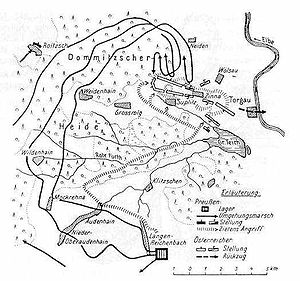Battle of Torgau
| date | November 3, 1760 |
|---|---|
| place | near Torgau , Saxony |
| output | Victory of the Prussians |
| Parties to the conflict | |
|---|---|
| Commander | |
| Troop strength | |
| 58,500 and 256 guns | 52,000 and 275 guns |
| losses | |
|
16,751 |
15,200 |
Eastern theater of war
Pirna - Lobositz - Prague - Kolin - Groß-Jägersdorf - Moys - Roßbach - Breslau - Leuthen - Domstadtl - Olmütz - Zorndorf - Hochkirch - Kay - Kunersdorf - Hoyerswerda - Maxen - Koßdorf - Landeshut - Liegnitz - Oschatz - Berlin - Wittenberg - Torgau - Döbeln - Burkersdorf - Reichenbach - Freiberg
The battle of Torgau on November 3, 1760 was the last major battle of the Seven Years' War .
procedure
Saxony was occupied by the Imperial Army. The Austrians under Field Marshal Leopold Joseph Daun wanted to connect with them near Torgau. Daun had established himself on the Süptitzer Heights with around 33,000 men and around 400 cannons. The location was well chosen: groves, barriers, ditches, ponds and marshes made every attack difficult and costly.
Friedrich II. Needed Saxony as a hub for supplies, as winter quarters for his army and as a bargaining chip for possible peace negotiations. He tried a new tactic here in order to carry out his plan: he divided up his troops and led three corps through the woods in order to bypass the heights and attack the Austrians from the north. Meanwhile, Hans Joachim von Zieten marched with the 4th Corps towards the south of the heights. The attack by the troops from the north and the south should begin simultaneously.
Zieten attacked too early and came across the St. Ignons Cavalry Corps, which was captured. This early attack almost became a disaster. Friedrich was now also attacking the heights, although most of his corps had not yet arrived.
When the cavalry finally intervened, they were thrown back by the Austrians. The second attack was more successful. The Austrian infantry was blown up. The Austrian cavalry ruined the success.
In the meantime Frederick II tried an attack from the north with ten battalions, which ended bloody. The cannon fire of the Austrian cannons caused the loss of 5,000 Prussian grenadiers within an hour.
After the main column arrived, Friedrich attacked a second time in vain. Daun now deployed his cavalry, which drove the Prussians back into the woods.
In the meantime, Daun had been wounded in the foot and was being treated in Torgau . The command of the imperial army was taken over by General Adolf Nikolaus von Buccow . Frederick II, who had two horses shot from under the body, was also wounded and believed, since he received no news of Zieten's fighting, that he lost the battle. Daun, through his adjutant general von Rothschütz, sent a hasty victory dispatch to Empress Maria Theresa in Vienna.
But at dusk the tide turned. At 6 p.m. Zieten's column captured the great Austrian battery. Zieten turned the cannons and fired at the Austrians. Two attempts to retake the cannons failed.
The victory of the Prussians was certain around 9 p.m. But it was an expensive win. With 16,751 men the Prussians lost more than 25% of their army, the Austrians with 15,200 men almost 30%. The battle was one of the bloodiest mass battles of the 18th century .
The Torgau March commemorates the victory.
Poetry
Theodor Fontane wrote the poem bei Torgau in memory of the battle :
The grenadiers don't want any more either.
The king chases along like a madman
and lifts his stick and shakes with a tremor:
"Rascals, do you want to live forever?
Troublemaker ... "
" Fritze, nothing of trouble;
It's enough for fifteen pfennigs today. "
Picture gallery
Frederick the Great before the Battle of Torgau (painting by Bernhard Rode 1791)
Frederick the Great after the Battle of Torgau (painting by Bernhard Rode, probably 1793)
Monument on the Süptitzer Heights
Web links
- 1760-11-03 - Battle of Torgau. Retrieved December 28, 2012 . (English)
- http://www.preussenweb.de
- http://www.wanderwelt-mittelachsen.de
literature
- Friedrich Ludwig Aster : Detailed report on how the strange battle at Siptitz near Torgau happened on November 3, 1760 . Hilscher, Leipzig 1776 ( digitized version )
- Hanns Joachim Friedrichs : World history, a chronicle , Novalis publishing house
- Volker Jäger: The Prussians are coming. Torgau in the three Silesian Wars 1740 to 1763 (Small writings of the Torgauer Geschichtsverein 22), Torgau 2010.
- Joachim Jeschke: The battle near Torgau on November 3, 1760. A Prussian Pyrrhic victory (Small writings of the Torgauer Geschichtsverein 21), Torgau 2010.
- Hannsjoachim W. Koch: History of Prussia , Bertelsmann Verlag
- Robert Schmidt: The 7 Years War between Elbe and Mulde (2007) , publishing, advertising and Phila service Robert Schmidt, Oschatz



